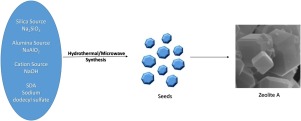当前位置:
X-MOL 学术
›
Colloids Surf. A Physicochem. Eng. Aspects
›
论文详情
Our official English website, www.x-mol.net, welcomes your
feedback! (Note: you will need to create a separate account there.)
Synthesis and characterization of Nano zeolite-A with aid of Sodium dodecyl sulfate (SDS) as particle size-controlling Agent
Colloids and Surfaces A: Physicochemical and Engineering Aspects ( IF 4.9 ) Pub Date : 2020-02-01 , DOI: 10.1016/j.colsurfa.2020.124427 Ishara Kannangara , Yohan Jayawardhana , Erandi Munasinghe , Anuradha Rajapakse , Athula Bandara , Rohan Weerasooriya , Lakmal Jayarathna
Colloids and Surfaces A: Physicochemical and Engineering Aspects ( IF 4.9 ) Pub Date : 2020-02-01 , DOI: 10.1016/j.colsurfa.2020.124427 Ishara Kannangara , Yohan Jayawardhana , Erandi Munasinghe , Anuradha Rajapakse , Athula Bandara , Rohan Weerasooriya , Lakmal Jayarathna

|
Abstract Synthesis of Nano zeolite-A has received considerable attention in the past decade and attracted profound attention as very essential commercial materials due to its nanoganic behavior., LTA Zeolites A (Linde Type A) are synthesized via low-temperature hydrothermal crystallization or microwave digestion methods in the presence of the ‘organic templates’. Generally, Tetramethylammonium-hydroxide (TMAOH) has been used as a template however, non-recyclablity, numerous efforts have been hampered the synthesis of environmental friendly template. In this work, nano zeolite-A was synthesized via both hydrothermal and microwave methods. An anionic surfactant, Sodium dodecyl sulfate (SDS) was used for controlling the particle size and as a site directing agent (SDA). The effects of different crystallization conditions such as aging time, synthesis time and temperature on the changes in particle size, morphology were investigated. The synthesized nano zeolite A was characterized by X-ray diffraction (XRD), scanning electron microscopy (SEM), Energy-dispersive X-ray (EDX), Fourier-transform infrared spectroscopy (FTIR) techniques. The obtained SEM and XRD results showed that both methods have ability to produce pure LTA zeolites crystallites with a 300−500 nm range in size with a high degree of crystallinity. However, lower aging temperature may cause for formation of sodalite (SOD) phase. Compared to the hydrothermal method, microwave approach is effective because it requires less time and produced narrow particle size distribution. Therefore, surfactant based zeolite-A synthesis would be potentially important in the chemical industry due to its competitive advantages as a green approach and cost-effectiveness.
中文翻译:

以十二烷基硫酸钠(SDS)为粒度控制剂的纳米沸石-A的合成与表征
摘要 纳米沸石-A 的合成在过去的十年中受到了相当大的关注,并且由于其纳米有机行为作为非常重要的商业材料受到了广泛的关注。LTA 沸石 A(Linde A 型)是通过低温水热结晶或微波消化合成的。存在“有机模板”的方法。通常,四甲基氢氧化铵(TMAOH)已被用作模板,但是,不可回收性,许多努力阻碍了环保模板的合成。在这项工作中,纳米沸石-A 是通过水热和微波方法合成的。阴离子表面活性剂十二烷基硫酸钠 (SDS) 用于控制粒径和作为位点导向剂 (SDA)。时效时间等不同结晶条件的影响 对合成时间和温度对粒径、形貌的变化进行了研究。通过X射线衍射(XRD)、扫描电子显微镜(SEM)、能量色散X射线(EDX)、傅里叶变换红外光谱(FTIR)技术对合成的纳米沸石A进行表征。获得的 SEM 和 XRD 结果表明,这两种方法都能够生产具有高度结晶度的尺寸范围为 300-500 nm 的纯 LTA 沸石微晶。然而,较低的时效温度可能会导致方钠石 (SOD) 相的形成。与水热法相比,微波法是有效的,因为它需要更少的时间并产生窄的粒度分布。所以,
更新日期:2020-02-01
中文翻译:

以十二烷基硫酸钠(SDS)为粒度控制剂的纳米沸石-A的合成与表征
摘要 纳米沸石-A 的合成在过去的十年中受到了相当大的关注,并且由于其纳米有机行为作为非常重要的商业材料受到了广泛的关注。LTA 沸石 A(Linde A 型)是通过低温水热结晶或微波消化合成的。存在“有机模板”的方法。通常,四甲基氢氧化铵(TMAOH)已被用作模板,但是,不可回收性,许多努力阻碍了环保模板的合成。在这项工作中,纳米沸石-A 是通过水热和微波方法合成的。阴离子表面活性剂十二烷基硫酸钠 (SDS) 用于控制粒径和作为位点导向剂 (SDA)。时效时间等不同结晶条件的影响 对合成时间和温度对粒径、形貌的变化进行了研究。通过X射线衍射(XRD)、扫描电子显微镜(SEM)、能量色散X射线(EDX)、傅里叶变换红外光谱(FTIR)技术对合成的纳米沸石A进行表征。获得的 SEM 和 XRD 结果表明,这两种方法都能够生产具有高度结晶度的尺寸范围为 300-500 nm 的纯 LTA 沸石微晶。然而,较低的时效温度可能会导致方钠石 (SOD) 相的形成。与水热法相比,微波法是有效的,因为它需要更少的时间并产生窄的粒度分布。所以,











































 京公网安备 11010802027423号
京公网安备 11010802027423号